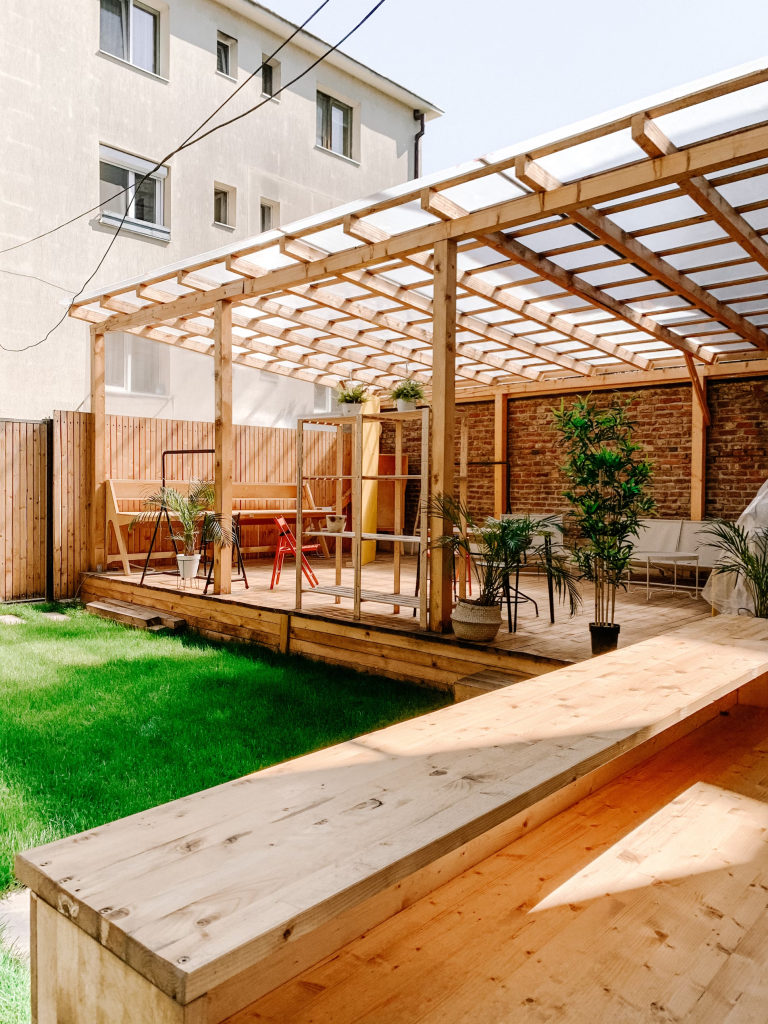A pergola is an outdoor architectural feature that provides a versatile space for relaxation, entertainment, and enjoyment of your garden or backyard. It is typically made up of vertical posts or pillars that support a roof structure, which is either open or partially covered.

Pergolas are one of the most popular outdoor features in Australian homes, offering a stylish and functional addition to gardens, patios, and terraces. But beyond its aesthetic appeal, a pergola serves multiple practical functions.
This article explores the various uses of a pergola, why it is a valuable investment, and how to maximise its potential in Australian homes.
Click Related Site For More Details
The Use Of Pergolas
Creating An Outdoor Living Space
One of the primary uses of a pergola is to create an outdoor living space that extends the functionality of your home into the outdoors. In Australia, where outdoor living is an integral part of the culture, a pergola offers a perfect space to relax, dine, or entertain guests in the fresh air while still being shielded from direct sunlight.
- Dining Area: A pergola can serve as an outdoor dining space, offering a comfortable and protected area to enjoy meals. With the addition of tables, chairs, and comfortable seating, the pergola becomes an inviting space for family dinners, barbecues, and gatherings with friends. Depending on your preference, you can add a retractable roof or shade sails for added sun protection during the summer months.
- Lounge Area: A pergola can be transformed into a lounge area with soft furnishings such as outdoor sofas, rugs, and cushions. Whether you’re reading a book, enjoying a coffee, or simply relaxing with family, a pergola offers a comfortable space to unwind while enjoying the natural beauty of your surroundings.
- Entertainment Space: A pergola is perfect for hosting parties, outdoor events, or casual get-togethers. With the right lighting, seating, and perhaps even a built-in barbecue or fire pit, a pergola becomes a stylish and functional entertainment zone. You can also incorporate sound systems for music or install a projector for outdoor movie nights.
Providing Shelter From The Elements
While pergolas are often associated with offering partial shade, they also serve as an effective means of protecting outdoor areas from harsh weather conditions.
- Shade and Cooling: The primary function of a pergola is to provide shade during the warmer months, allowing homeowners to enjoy their outdoor space without the discomfort of direct sunlight. With the addition of retractable roofs, shade cloths, or vines, a pergola can provide varying degrees of sun protection, keeping the space cooler and more comfortable.
- Protection from Light Rain: Although pergolas are typically open structures, they can still offer shelter during light rain showers. With a slatted roof or a canopy, a pergola can provide enough protection to ensure that guests and outdoor furniture remain dry during brief, light rain. For more heavy-duty weather protection, you can opt for a more solid roof or consider installing weather-resistant blinds.
- Wind Protection: In addition to shielding you from the sun, pergolas can also act as a windbreak in certain areas of the garden or outdoor space. When combined with side panels or screens, a pergola can reduce the impact of strong winds, creating a more comfortable space for outdoor living, particularly during the cooler months.
Enhancing The Aesthetic Appeal Of Your Garden
Pergolas are renowned for their ability to elevate the aesthetic appeal of gardens, patios, and backyards. They serve as a focal point that adds style, elegance, and sophistication to outdoor spaces.
- Architectural Appeal: A pergola brings structure and form to an otherwise flat garden, creating an eye-catching feature. It can complement both modern and traditional landscaping styles, depending on the materials and design chosen. Whether it’s a rustic timber structure or a sleek steel frame, a pergola adds a sense of purpose and character to any outdoor space.
- Vertical Garden Feature: Pergolas are also ideal for growing climbing plants, vines, and flowers. The open structure provides support for plants such as jasmine, wisteria, clematis, and ivy, which can cover the frame and create a natural green canopy. This vertical garden feature adds a touch of nature and tranquillity to your outdoor space while also offering more shade.
- Creating a Focal Point: A well-positioned pergola can act as the focal point in your garden, creating an inviting atmosphere and framing a specific area, such as a pool, garden bed, or pond. It can also be used to highlight a particular feature in your landscape, such as a sculpture, fountain, or seating area.
Maximising Outdoor Entertainment Potential
In Australia, where outdoor living is so highly valued, a pergola can be the centrepiece of outdoor entertaining. Whether hosting large gatherings or intimate get-togethers, a pergola provides a perfect setting for guests to mingle, enjoy meals, and relax under the open sky.
- Barbecues and Outdoor Cooking: Australian summers are synonymous with barbecues, and a pergola provides an excellent setting for an outdoor kitchen or a barbecue area. With the right additions, such as built-in cooking equipment, a sink, and countertops, the pergola can become a dedicated outdoor cooking zone where you can prepare and serve meals in style. The shaded area also helps to keep you cool while grilling, making it more comfortable to entertain outdoors during the heat.
- Alfresco Dining: Alfresco dining is a popular Australian pastime, and a pergola creates an ideal environment for enjoying meals outdoors. Whether you’re having a casual family lunch or hosting a dinner party, a pergola offers a comfortable, sheltered environment to dine in while enjoying the fresh air and pleasant surroundings.
Increasing Property Value
Adding a pergola to your home can significantly increase its market value. Potential homebuyers often view outdoor living spaces as an attractive feature and a pergola can make your property more desirable.
- Appealing to Buyers: A well-designed pergola can add both functional and aesthetic value to your home, making it more appealing to prospective buyers. If your property includes a beautifully landscaped garden, a pergola can enhance the overall visual appeal and create a more inviting atmosphere.
- Maximising Outdoor Space: Homes with pergolas benefit from maximised outdoor living areas. A pergola allows you to utilise your garden or backyard more effectively, transforming an underused space into a functional and attractive area for outdoor activities, relaxation, and entertainment.
Adding Privacy To Outdoor Spaces
Pergolas can be adapted to provide a level of privacy in your outdoor living area. Whether you want to create a private sanctuary in your garden or shield your seating area from prying eyes, a pergola can be designed with privacy in mind.
- Privacy Screens or Curtains: By incorporating privacy screens, drapes, or lattice panels, a pergola can block views from neighbours and passers-by. These additions can also provide some protection from wind and create a sense of seclusion, allowing you to fully enjoy your outdoor space without feeling exposed.
- Dividing Garden Spaces: A pergola can be used to separate different areas of your garden or yard, creating designated zones for different activities. For example, it can serve as a barrier between a dining area and a vegetable garden or be used to divide a pool area from the rest of the backyard.
Offering Flexibility And Customisation
Pergolas are highly customisable structures that can be designed to suit a variety of needs, tastes, and available space. From the material to the roof design, pergolas offer flexibility in how they are built and used.
- Material Choices: Pergolas can be constructed from a variety of materials, including timber, steel, aluminium, or even wrought iron. The choice of material will depend on your budget, aesthetic preferences, and the climate of your area. Timber pergolas offer a natural, rustic look, while steel or aluminium frames tend to suit more contemporary designs.
- Roof Options: The roof of a pergola can be open, partially covered, or fully enclosed, depending on how much protection you need from the elements. For extra shelter, you can choose from options like polycarbonate roofing, canvas covers, or retractable roofing systems.
- Size and Shape: Pergolas can be built in various shapes and sizes, from small structures that cover a single seating area to larger, more elaborate designs that span over entire courtyards. This adaptability makes pergolas suitable for a wide range of properties, whether you live in a townhouse or a larger suburban home.
Encouraging Social Interaction And Relaxation
The open, inviting design of a pergola encourages social interaction and fosters a relaxed atmosphere. Whether you’re spending time with family or entertaining friends, the pergola is an excellent place for connection and enjoyment.
- Social Hub: The structure’s open design allows for easy movement, and the space can be configured to accommodate large groups or small gatherings. This encourages conversations, games, or activities in a setting that blends indoor and outdoor living.
- Relaxation and Well-being: For many, spending time outdoors contributes to improved well-being, and a pergola offers the perfect setting to connect with nature. The space provides a sense of calm and tranquillity, ideal for meditation, yoga, or simply unwinding after a long day.
Conclusion
A pergola is a versatile outdoor feature that serves many functions, from creating a stylish space for outdoor entertaining to providing shelter and privacy. In Australian homes, where outdoor living is cherished, a pergola can significantly enhance the functionality, aesthetic appeal, and value of your property.
Whether you’re looking to create a relaxing garden retreat, an alfresco dining area, or an entertaining space, a pergola offers the flexibility to meet your needs. With careful planning and the right design, a pergola can transform your outdoor living experience, making it an invaluable addition to any home.
Frequently Ask Question
What Is The Difference Between A Pergola And A Gazebo?
A pergola is typically an open structure with a roof made from beams or lattices, providing partial shade and serving as an outdoor feature. It is often used as a passageway or an extension of the garden and is ideal for climbing plants.
A gazebo, on the other hand, is usually a freestanding, fully enclosed structure with a solid roof that offers full protection from the elements. Gazebos often have walls and can be used as a more enclosed space for relaxation, while pergolas are more open and airy.
How Do I Maintain My Pergola?
Maintaining a pergola is relatively simple but depends on the material. For timber pergolas, regular cleaning and re-sealing are recommended to protect the wood from weathering, rot, and insects. Steel and aluminium pergolas are low-maintenance but should be cleaned occasionally with a mild detergent to keep them looking their best.
If your pergola has climbing plants or vines, ensure that they are regularly trimmed to prevent damage to the structure. It’s also important to check for signs of wear and tear, like loose bolts or damaged beams, and address them promptly.
What Plants Can I Grow On A Pergola?
Pergolas are ideal for growing climbing plants, as the beams and lattice provide support for the plants to spread and grow. Popular choices for pergolas in Australia include jasmine, wisteria, climbing roses, passionfruit, and grapevines.
These plants not only add beauty and fragrance to the space but also provide extra shade during hot Australian summers. Make sure to choose plants that are suitable for your local climate and will thrive in your garden.
